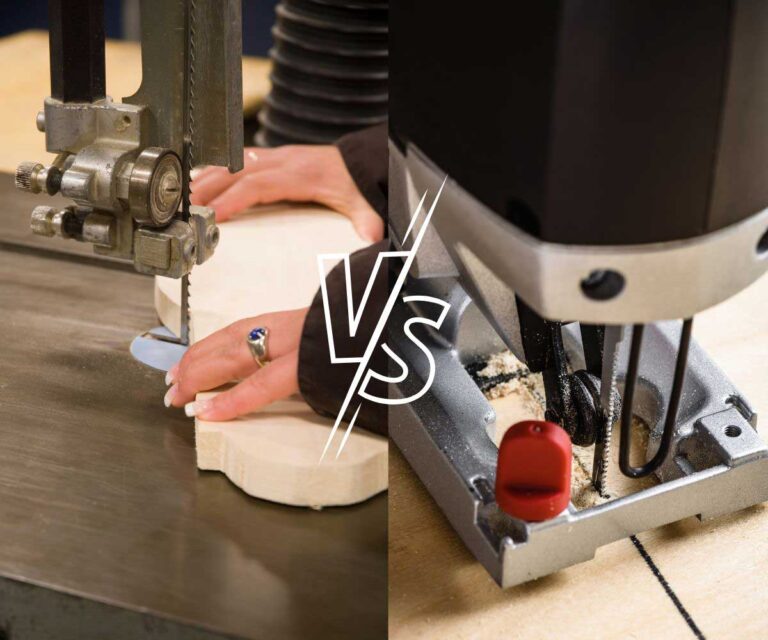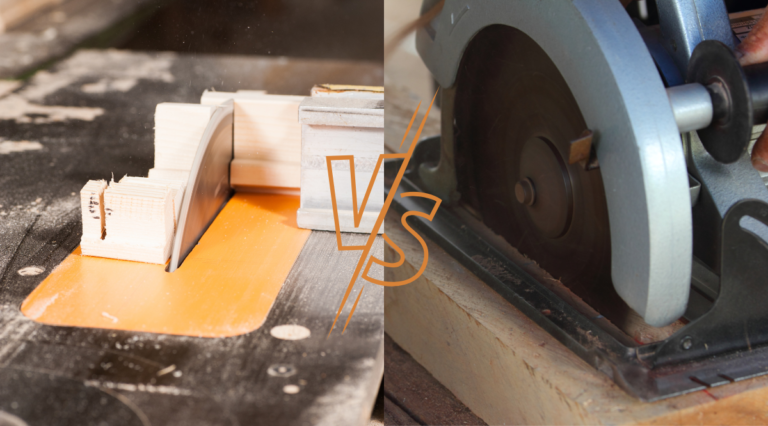Sawzall Vs Jigsaw – Comparison, Pros, Cons & More!
As an Amazon Associate I earn from qualifying purchases.
A Sawzall and a jigsaw can do a lot of work like cutting wood, plywood, metal, plastic, and even ceramic tile. But their cuts differ from each other.
A Sawzall is more versatile, handles heavy-duty work better, and can cut both vertically and horizontally.
Sawzall is a heavy-duty reciprocating saw for demolition and rough cuts, while Jigsaw is a finesse tool for precise cuts.
In contrast, a jigsaw is less costly and preferable for delicate, intricate, and curved vertical cuts.
Both saw have their own advantages and disadvantages for providing different cuts on different materials. Here I will give you a detailed comparison between Sawzall vs Jigsaw so that you can quickly identify which one is needed in which context to have the best tool for your desired project.
Contents
Comparison Table between Sawzall vs Jigsaw
| Features | Sawzall | Jigsaw |
| Generate power | Up to 15amp | Up to 7.2amp |
| Speed | Faster | Fast |
| Blade type | Universal Sabre shank | T-shank and U-shank |
| Main purpose | Demolition and remodeling | Cutting and shaping |
| Power supply | Corded and cordless | Corded and cordless |
| Cut quality | Smooth | Rough |
| Cuts | Horizontally and vertically | Vertically |
| Inside cut | Yes | Yes |
| Curve cut | Average | Better |
| Straight cut | Average | Better |
| Deep cut | Deeper | Less deep |
| Round edges | No | No |
| Changing blades | Easy | Easy |
| Weight | Less | More |
| Safety | Better | Good |
| Maintenance | Easy | Easy |
| Portable | Yes | Yes |
| Price | Affordable | More Affordable |
Pros & Cons Between Jigsaw Vs Sawzall
Jigsaw
Like the Sawzall, the Jigsaw also spins the blade in the push-and-pull mechanism. Although it is slower than a Sawzall, it can provide delicate, complex shapes, curves, and straight cuts.
Being lightweight, this saber saw is holdable and usable for a long time and comes in both corded and cordless versions for easy portability.
Sawzall
A Sawzall is a high-powered wood-cutting handheld tool with a push-and-pull blade mechanism.
Capable of cutting both horizontally and vertically to provide more flush cuts and straight cuts. This hognose-design saw comes in both corded and non-corded versions for easy portability.
Comparison between a Jigsaw and Sawzall saw
A Sawzall and Jigsaw use the same materials blade and can cut almost the same materials. However, they do have similarities and dissimilarities in many other terms that give one an advantage and another a disadvantage. So let’s get all of them.
Design
A Sawzall saw is a much larger tool with a horizontal, hognose design. For this design, it can make cuts in odd areas. In contrast, a jigsaw is a small, more compact, vertical C-shaped tool.
Generating power
A Sawzall can generate more power than a jigsaw. For example, it can generate up to 15amp power, while the Jigsaw can generate up to 7.2apm power. As it generates more power, a Sawzall moves the blade at a faster speed and cuts harder materials in less time.
Blade types
A Sawzall uses a universal Sabre Shank blade that can be used with any saw. In contrast, a jigsaw uses two types of blades; T-shank and U-shank.
Currently, most modern saws come with T-shank blade support as T-shank blades are easy to install and cause less breakage.
Blade change
Both saws make changing the blade easier, but replacing the Jigsaw T-shank design blade is far superior. Here, you just have to spin the spring-loaded clamp and place the blade.
In contrast, Jigsaw U-shank and Sawzall universal blade changes are more difficult; you must unscrew to remove the old one and tighten the screw to install the new one.
Usage
A jigsaw can be used to cut shapes, straight lines, angle lines, more complicated cuts, and curve cuts. In comparison, a Sawzall saw can perform practically all jigsaw cuts but less delicately.
Operating
Both saws move the blade in the same push-and-pull mechanism. But a jigsaw can operatable only in a vertical direction and needs a flat surface to work as the blade teeth are in the upper direction; it can’t cut horizontally.
In contrast, a Sawzall can be operatable in both horizontal and vertical directions as its blade teeth are in a lower direction.
Cuts
Depending on the teeth’s size and blade material, both a jigsaw and reciprocating saw can cut wood, plywood, plastic, metal, and ceramic tile.
However, due to the slower speed of the blade movement, a jigsaw will offer a smoother, more precious, and finer cut while cutting shapes, curves, and intricate cuts.
Though the cut will be rough on a Sawzall, you will be able to cut faster and in more hard materials and places, such as on a vertical wall, the smallest layers of the window frame, pruning trees, and odd areas.
Depth of cuts
The blade size and design determine a saw’s depth of cut. Usually, a Sawzall blade can be 3 to 12 inches long, and for horizontal hognose design can cut material up to 10 inches thicker than a jigsaw.
In contrast, a jigsaw blade can be 3 to 10 inches long, and for a long shoe design, it can cut a maximum of 6 inches thick material less than Sawzall.
Weight and size
A Sawzall saw weighs more and size larger than a jigsaw for its horizontal hognose design. Therefore, while operating a Sawzall horizontally, it feels heavier to hold than a jigsaw.
Versatility
Both multipurpose saws make cuts of almost the same type of materials, portable and easily holdable in the hand while cutting. But as a Sawzall can cut both horizontally and vertically, even in odd areas, this saw is more versatile than a jigsaw.
Accuracy
A jigsaw blade moves slower than a Sawzall saw and works on a flat surface that gives a jigsaw more accuracy in making precious cuts and helps to provide straighter, more intricate, and curve cuts.
Burning
A Sawzall saw blade moves faster than a jigsaw that generates more heat which can cause burn marks while cutting thick materials.
Safety
While cutting with a jigsaw, one hand must be placed on the material surface for any time that can come into contact with the jigsaw blade and cause an accident. In Sawzall, you don’t have to think about it.
Price
Comparing different models, I got the Jigsaw is more affordable than the Sawzall. Spending around $50 to $200, you will get an average to good quality jigsaw and Sawzall.
Which One should I choose: Sawzall Saw or Jigsaw
Depending on the cut quality and usage, if you need a saw that is more versatile to cut both horizontally and vertically and can handle heavy-duty workloads like demolition and remodeling jobs with deeper and odd area cuts, then choose Sawzall.
On the other hand, if you need a saw with great accuracy and great control to ensure more precious and delicate cuts, including complex and curved cuts, at a lower price, then choose Jigsaw.
Note: For both horizontal and vertical cutting capability, you use a Sawzall instead of a jigsaw but can’t use a jigsaw instead of a Sawzall saw.
Frequently Asked Questions
Q. Can I use a jigsaw to cut tree branches?
Ans: You can use a jigsaw to cut tree branches. Jigsaw blades are not preferable to cut green wood like tree branches; they could jump like a spring and could slide much.
To avoid this problem, you have to choose fewer teeth per inch blade, run the Jigsaw at a slow speed and grip the Jigsaw tightly; following these, you can’t cut not only the small branches but also the large branches.
Q. Can you cut wet wood with a Sawzall?
Ans: Yes, you can easily cut wet wood with a Sawzall. As the Sawzall comes in a horizontal hognose design, blade teeth are in a lower direction and need both hands to hold the saw; all these ensure better support to avoid jumping like a spring and sliding to cut wet wood like branches and trees.
Q. Can a Jigsaw Cut Metal?
Ans: Usually, with any jigsaw blade, you can easily cut metals but won’t get a fine result. For that, you have to use an HSS or Carbine blade with 20 to 35 Teeth per inch for cutting any hard metals.
Note: Cut at a lower speed and use old blades for better results.
Conclusion
A jigsaw and a Sawzall both have a specialty in a different context of work. Where one ensures great accuracy and another ensures great versatility.
Earlier I compared them and described all of their advantages and disadvantages so that you can easily choose one for your project to have the desired result. Thank you.






